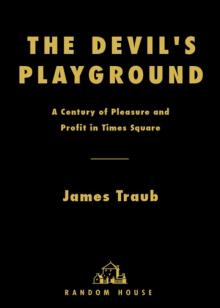The Devil's Playground: A Century of Pleasure and Profit in Times Square 

by James Traub
Genre: Other9
Published: 2004
View: 3171
Read OnlineRead The Devil's Playground: A Century of Pleasure and Profit in Times Square Storyline:
From Publishers WeeklyThe first part of Traub's learned cultural history focuses on Times Square (originally Longacre Square before it was renamed in 1904) when it was the center of New York'sâ€"and the nation'sâ€"entertainment industry. Evoking the Runyonesque worlds of vaudeville, burlesque, speakeasies, gangsters and molls, the author provides lots of glamorous information about old Times Square and its most recognizable inventionâ€"oversized electronic signs or "spectaculars." Part two opens in the 1970s after Hollywood, suburbanization and television had marginalized live entertainment and its capital, turning Times Square into a haven for drug dealers and prostitutes, "a disease to be cured." This section, on the rebirth of Times Square, is particularly valuable for showing how private interests and the public sector joined forces to create a capital for corporatized fun. In part three, some readers may become impatient with Traub's tortured indecision about whether to enjoy this weird, overblown world, as his 11-year-old son does, or to decry it as a plot by global capitalism, as well as with his tendency to obsessively analyze the place (he visits Madame Tussaud's Wax Museum with a professor who's "a deconstructionist, or perhaps a postdeconstructionist"). Despite the sometimes overly intellectual approach, this book should appeal to those looking for some of the joy and excitement that even the new "sanitized" Times Square has to offer. Copyright © Reed Business Information, a division of Reed Elsevier Inc. All rights reserved. From BooklistStarred Review Traub has made a career out of writing about New York and its institutions. He has the right: he lives and breathes the city, and his prose tumbles out sparkling and effortless. His history of Times Square--its name was changed from Longacre Square in the spring of 1904 for the newspaper headquartered there--is a vivid and remarkably nonjudgmental tale. The "iron law" of Times Square, he writes, is "real estate turned to its most profitable use," and he carries that idea from rooftop gardens, vaudeville, and the magical year of 1927 through the speakeasies and nightclubs of the 1930s to the sinkhole of the 1970s and the square's current incarnation as the site of a family carnival. He doesn't miss a character--what made Times Square happen were personalities from reporter Walter Winchell and nightclub queen Texas Guinan to designer Tibor Kalman and the real estate Dursts. He segues smoothly from the assignations of boxer Primo Carnera at the Forrest Hotel to the effect of crowds on MTV's Total Request Live. He pauses in his archaeological reconstruction long enough to marvel at the length and depth of Irving Berlin's career and to admire the Ferris wheel inside the Toys R Us store. A fabulous read that quite nearly captures the "gorgeous disarray" and "epic higgedly piggedly" of the world's gathering place. For other slices of New York life, see Donna Seaman's Read-alike column, "Walkabout, New York Style," in the February 1, 2004, Booklist. GraceAnne DeCandidoCopyright © American Library Association. All rights reservedPages of The Devil's Playground: A Century of Pleasure and Profit in Times Square :